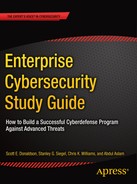Scott E. Donaldson, Stanley G. Siegel, Chris K. Williams and Abdul Aslam
Enterprise Cybersecurity Study GuideHow to Build a Successful Cyberdefense Program Against Advanced Threats

Scott E. Donaldson
Falls Church, Virginia, USA
Stanley G. Siegel
Potomac, Maryland, USA
Chris K. Williams
San Diego, California, USA
Abdul Aslam
San Diego, California, USA
Any source code or other supplementary material referenced by the author in this book is available to readers on GitHub via the book's product page, located at
www.apress.com/9781484232576
. For more detailed information, please visit
http://www.apress.com/source-code
.
ISBN 978-1-4842-3257-6e-ISBN 978-1-4842-3258-3
Library of Congress Control Number: 2018935923
© Scott E. Donaldson, Stanley G. Siegel, Chris K. Williams, Abdul Aslam 2018
This work is subject to copyright. All rights are reserved by the Publisher, whether the whole or part of the material is concerned, specifically the rights of translation, reprinting, reuse of illustrations, recitation, broadcasting, reproduction on microfilms or in any other physical way, and transmission or information storage and retrieval, electronic adaptation, computer software, or by similar or dissimilar methodology now known or hereafter developed.
Trademarked names, logos, and images may appear in this book. Rather than use a trademark symbol with every occurrence of a trademarked name, logo, or image we use the names, logos, and images only in an editorial fashion and to the benefit of the trademark owner, with no intention of infringement of the trademark. The use in this publication of trade names, trademarks, service marks, and similar terms, even if they are not identified as such, is not to be taken as an expression of opinion as to whether or not they are subject to proprietary rights.
While the advice and information in this book are believed to be true and accurate at the date of publication, neither the authors nor the editors nor the publisher can accept any legal responsibility for any errors or omissions that may be made. The publisher makes no warranty, express or implied, with respect to the material contained herein.
Printed on acid-free paper
Distributed to the book trade worldwide by Springer Science+Business Media New York, 233 Spring Street, 6th Floor, New York, NY 10013. Phone 1-800-SPRINGER, fax (201) 348-4505, e-mail [email protected], or visit www.springeronline.com. Apress Media, LLC is a California LLC and the sole member (owner) is Springer Science + Business Media Finance Inc (SSBM Finance Inc). SSBM Finance Inc is a Delaware corporation.
To my growing family: Shelly, Ashleigh, Melanie, Manoli, Nick, Stephanie, David, Jackson, Mason, Julia, Laura, and Justin
—Scott Donaldson
To Bena, my wife, and our grandchildren: Eva, Ezra, Avi, Raffi, Tal, Eli, Zoe, Sarah, Emma, and Simcha
—Stan Siegel
To my father, Dennis, who taught me to protect those whom you love, and love those whom you protect
—Chris Williams
To my parents: Zahida, Maqbool, Shamim, and Imam. And to my loves: Sharu, Ishaq, Farhan, and Zayd
—Abdul Aslam
About this Study Guide
Preface
This study guide is an instructional companion to the book
Enterprise Cybersecurity: How to Build a Successful Cyberdefense Program Against Advanced Threats
. This study guide increases students’ understanding of the book’s ideas, whether they are using it in the classroom or for self-study. The study guide is structured to be self-explanatory and is intended to augment the book’s content. For additional information and detail on the topics covered in this study guide, please reference
Enterprise Security: How to Build a Successful Cyberdefense Program Against Advanced Threats
by Scott E. Donaldson, Stanley G. Siegel, Chris Williams, and Abdul Aslam (Apress, 2015) (
www.apress.com/9781430260820
).
Implementing a successful cyberdefense program against real-world attacks is what
Enterprise Cybersecurity
is about. Often in cybersecurity, everyone knows
what should be done
, but resources
to do it
are not sufficient. Organizations must prioritize their efforts to deploy an incomplete solution that they “hope” is sufficient. The challenge lies in how to prioritize resources so security can be as successful as possible. As shown in Figure
P-1
, the Cybersecurity Conundrum often gets in the way of what needs to be done, leaving gaps in enterprise cyberdefenses that are exploited by clever attackers.
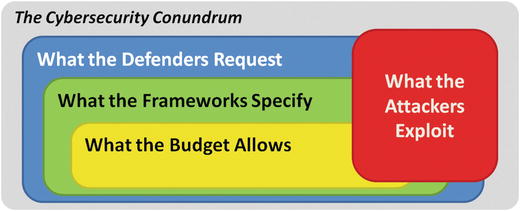

Figure P-1.
Even though the cybersecurity conundrum presents significant challenges, implementing a successful cyberdefense program that works against real-world attacks is achievable.
One Cybersecurity Conundrum challenge is that cybersecurity professionals want to implement more than what control frameworks specify and much more than what the budget allows. Ironically, another challenge occurs even when defenders get everything that they want; clever attackers are extremely effective at finding and exploiting the gaps in defenses, regardless of their comprehensiveness. The overall challenge, then, is to spend the available budget on the right protections so that real-world attacks can be thwarted without breaking the bank and that they also comply with mandated regulatory requirements.
Intended Audiences
As shown in Figure
P-2
, people involved in or interested in successful enterprise cybersecurity can use this study guide to gain insight into an effective architecture for coordinating an entire cyberdefense program.
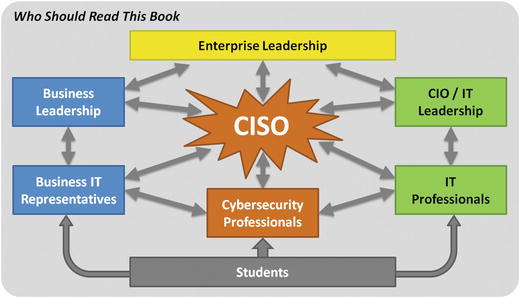

Figure P-2.
Successful enterprise cybersecurity is a team sport.
This study guide is intended for the following audiences:
- Everyone involved in or interested in successful enterprise cybersecurity . This study guide offers material for those who want to use the book to help them do their work. Such individuals can use this material to learn about cybersecurity and its challenges, cybersecurity implementation, effective cyberdefenses, pragmatic cyberincident response, cybersecurity program assessments, and cybersecurity program management. In short, this study guide helps those who need to understand the challenges of delivering effective cybersecurity solutions.
- Students . This study guide recasts the book’s contents as presentation material. This material is organized according to the chapter organization of the original book, with major points appearing generally in the same order as they appear in the book. Most of the book’s figures, or adaptations of these figures, appear in this study guide. Students can use this material in a number of ways in conjunction with the text to include the following examples:
- Before reading a chapter or part of a chapter from the book, students can go to the corresponding study guide pages to get a quick look at the chapter or chapter part and understand its major points and themes.
- While reading a chapter or chapter part, students can, in parallel, look at the corresponding study guide pages. Sometimes a different look at the same material can facilitate learning.
- After reading a chapter or chapter part, students can go to the corresponding study guide pages to quickly review key points, concepts, and descriptive figures.
- Instructors . This study guide offers material that instructors can use to develop classroom presentations based on the book’s contents. Instructors can also use these pages to incorporate material from the book into other courses. For example, an instructor may be teaching a course (or part of a course) on the topic of cybersecurity assessments. If such a course is presenting different approaches to cybersecurity assessments, “Chapter 11 : Assessing Enterprise Cybersecurity” and/or “Appendix D: Cybersecurity Sample Assessment” in this study guide may offer the instructor ready-made material for demonstrating one example of a comprehensive assessment methodology.
Using Study Guide Material
This study guide material can be used in a number of ways that include the following:
- Corporate Education . This material can be used to teach a short course to employees within an organization or to teach a more detailed course targeted at cybersecurity professionals. The course can address all the book’s material or selected material for special topics.
- University Education . This material is suitable for a course at the undergraduate and graduate levels. The material can be covered quickly in a single overview course, or it can be covered in more detail as part of a larger cybersecurity instruction program. When considered in depth, the material of this study guide may be too extensive to be thoroughly covered in a one-semester, three-credit course.This guide can be used to structure short presentations on selected topics from the book. In the university environment, this approach can be used to structure a graduate-level special topics seminar spanning multiple weeks, and perhaps meeting for a couple of hours each week to discuss detailed topics drawn from the book and other industry literature. Such a seminar might be used to help students conduct their own research and assess other information sources from books, literature, and the Internet.
- Professional Conferences and Meetings. The authors offer the following suggestions to those involved with establishing cybersecurity training programs:
- This material can be used to give presentations at professional conferences and other meetings pertaining to cybersecurity (such as the Information Systems Security Association [ISSA]).
- This material can be used to structure short presentations (say, one hour) to introduce employees to key cybersecurity-related topics such as common cybersecurity attacks, cybersecurity frameworks, cybersecurity policy, and cybersecurity operational processes.
- This material can be used to structure half-day or longer presentations dealing with the how-tos of such topics as cybersecurity assessments audits and measuring a cybersecurity program.
- The material can be used to augment existing training activities:
- The material found in “Appendix C: Object Measurement” can be added to an existing presentation on measurement. One purpose of such an addition would be to illustrate alternative ways of addressing the challenging problem of meaningful cybersecurity measurement.
- This material can be added to a new module as a self-contained presentation. For example, a company may have one or more training modules dealing with different aspects of the business case for cybersecurity improvement. This material could be included in a module that focuses on return on investment, while another module might focus on cybersecurity effectiveness.
How This Study Guide Is Organized
- IntroductionThe introduction lays the groundwork for subsequent discussions on how to start, continue, and improve an enterprise’s cybersecurity. This section provides an introductory understanding of cybersecurity and explains how cybersecurity is with us to stay.
- Part I: The Cybersecurity ChallengePart I is about the cybersecurity challenge and how cybersecurity has changed over the past decade. Due to this evolution, the cyberdefense methods that worked well in the past are doomed to fail in the future.
- This chapter defines the cybersecurity challenge facing the modern enterprise and discusses the threats against its defenses and why those threats are succeeding at an alarming rate.
- This chapter describes how the cybersecurity challenge can be met and how cybersecurity controls and capabilities can be organized to prevent, detect, document, or audit malicious behavior.
- Part II: A New Enterprise Cybersecurity ArchitecturePart II introduces a new enterprise cybersecurity architecture that is designed to organize and manage every aspect of an enterprise cybersecurity program, including policy, programmatics, IT life cycle, and assessment.
- This chapter describes the new enterprise cybersecurity architecture and explores 17 functional areas in terms of their goals and objectives, threat vectors, and underlying capabilities.
- This chapter discusses how to implement the new enterprise cybersecurity architecture by identifying security scopes, defining security policies, and selecting security controls to counter anticipated threats.
- This chapter explains how to operate enterprise cybersecurity capabilities and processes, including 17 operational processes and 14 supporting information systems essential to effective enterprise cybersecurity.
- This chapter discusses how cloud computing is different from the conventional data center and explains how the new architecture needs to be tailored for cloud computing environments.
- This chapter describes the trends of mobile computing and Bring Your Own Devices (BYODs) and how these two trends solve problems and introduce challenges for the new architecture.
- Part III: The Art of CyberdefensePart III discusses the art of cyberdefense and how the new architecture is deployed and used to provide effective risk mitigation and incident response for cybersecurity crises.
- This chapter examines why attackers have great success against legacy cyberdefenses, how the steps of the attack are sequenced and how to disrupt them, and how to layer cyberdefenses so they effectively thwart targeted attacks.
- This chapter describes the incident response process in detail by considering what the enterprise needs to do on an ongoing basis to investigate, contain, and remediate cybersecurity incidents when they occur.
- This chapter discusses how severe cybersecurity incidents become crises and how the enterprise must behave differently in a crisis situation while it struggles to restore normal operations.
- Part IV: Enterprise Cyberdefense AssessmentPart IV establishes a methodology for quantitatively and objectively assessing cybersecurity using the enterprise cybersecurity architecture and then mapping those assessments against major frameworks for reporting purposes.
- This chapter explains the cybersecurity assessment and auditing process, and provides four worked-out examples using the new architecture to assess cybersecurity posture and effectiveness.
- This chapter provides a comprehensive method for objectively measuring an enterprise’s cybersecurity by looking at risk mitigations, cybersecurity functional areas, and security operations.
- This chapter explains how to take the results of an enterprise cybersecurity assessment and map them against other cybersecurity frameworks for the purpose of evaluation, audit, or compliance reporting.
- Part V: Enterprise Cybersecurity ProgramPart V brings together the concepts of the rest of the book into a comprehensive enterprise cybersecurity program that combines assessment, planning, prioritization, implementation, and operations.
- This chapter explains the cybersecurity program management process and shows how the enterprise can use it to manage cybersecurity decision-making and prioritize improvements to get the best possible value for the investment.
- This chapter concludes the study guide by discussing the evolution of generations of cyberattacks and cyberdefenses, and how enterprise cybersecurity architecture will evolve over time to support the enterprise’s needs now and in the future.
- Part VI: AppendicesThe appendices provide greater detail than the chapters and provide important details and examples for cybersecurity practitioners who want to use the enterprise cybersecurity architecture described in this study guide.
- Appendix A: Sample Cybersecurity PolicyThis appendix provides a sample enterprise information security policy document, organized into the 11 functional areas of the new architecture described in this study guide.
- Appendix B: Cybersecurity Operational ProcessesThis appendix contains detailed flowcharts for the 17 operational processes of enterprise cybersecurity, and it also introduces the 14 supporting information systems.
- Appendix C: Object MeasurementThis appendix introduces the Object Measurement Methodology for objective assessment and explains how to use it to measure and report enterprise cybersecurity architecture effectiveness.
- Appendix D: Cybersecurity Sample AssessmentThis appendix provides an example enterprise cybersecurity assessment using the methodology contained in this study guide, providing multiple levels of details showing how different types of assessment can be performed.
- Appendix E: Cybersecurity Capability Value ScalesThis appendix contains detailed, example Object Measurement value scales for measuring the performance of each of the 113 enterprise cybersecurity architecture capabilities, grouped by the 11 functional areas.
Summary
- This study guide is an instructional companion to the book Enterprise Cybersecurity: How to Build a Successful Cyberdefense Program Against Advanced Threats .
- This study guide contains landscape-formatted pages that recast the book’s content and new content as presentation material.
- This material is organized according to the chapter structure of the original book and is laid out in the order that it appears in each chapter.
- This study guide is intended for everyone involved in or interested in successful enterprise cybersecurity (business professionals, IT professionals, cybersecurity professionals, students, and so on).
- Students, cybersecurity professionals, and IT professionals can use this study guide in a self-study manner. Students can also use this study guide to facilitate note-taking in the classroom.
- Instructors can use this study guide to develop classroom presentations based on the book’s contents.
- This study guide, in conjunction with the book, can be used by anyone who wants to learn and apply what it takes to build a successful cyberdefense program against advanced threats.
Introduction
Enterprise Cybersecurity Study Guide: How to Build a Successful Cyberdefense Program Against Advanced Threats
Today’s Discussion
- Overview
- Intended Audience
- What is an enterprise ?
- What is cybersecurity ?
- Cybersecurity Conundrum
- Axioms of a “Next-Generation” Cyberdefense
- The Cyberattacks of Today
- Successful Cybersecurity Program
- Cybersecurity Program Cycle
- Future Discussion Topics
Overview
- Provide an introductory understanding of cybersecurity
- Explain why cybersecurity is with us to stay
- Explain why everyone needs to understand cybersecurity
- Lay the groundwork for subsequent discussions that detail how to start, continue, and improve an enterprise’s cybersecurity
Intended Audience
- Enterprise Leadership
- Oversight responsibility for information technology and cybersecurity concerns within an enterprise (for example, organization, business, or government agency)
- Business or Organizational Leadership
- Responsible for achieving enterprise objectives while using information technology systems and protecting sensitive and valuable information
- Business or Organization IT Representative
- Responsible for delivering business capabilities using information technology and complying with cybersecurity requirements
- Chief Information Security Officer (CISO)
- Responsible for overseeing a comprehensive enterprise cybersecurity program
- Cybersecurity Professional
- Responsible for managing, deploying, and operating effective cyberdefenses within the enterprise
- Chief Information Officer (CIO) or Information Technology (IT) Leadership
- Responsible for deploying information technology solutions to deliver business value while complying with regulatory and security requirements
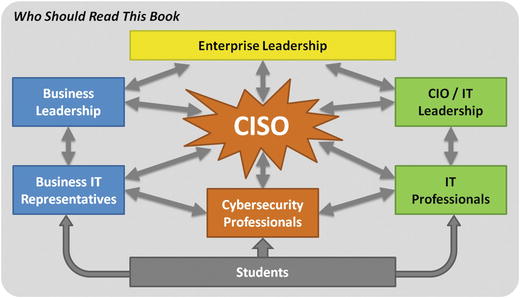
- IT Professionals
- Responsible for ensuring information technology solutions have adequate cybersecurity while also delivering value to the enterprise
- Students
- Learning about business, information technology, or cybersecurity, and need to understand the challenges of delivering effective cybersecurity solutions
What is an enterprise?
- An enterprise is an organization that uses computers and computer networks for personal, business, nation-state, or other purposes, and has authority over those computers and computer networks.
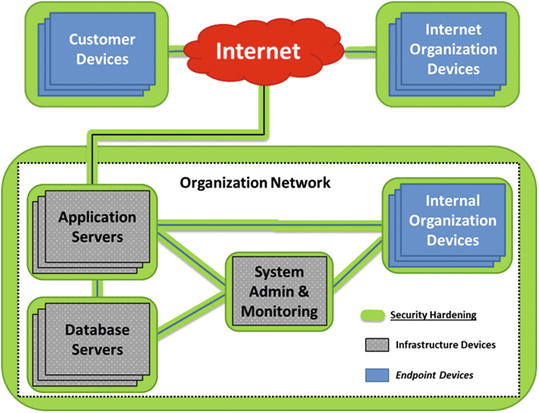
- An enterprise may range from an individual’s personal computer and network to a corporate or governmental entity with thousands or hundreds of thousands of computers connected to networks spanning the globe.
What is cybersecurity?
- Cybersecurity is the practice of protecting the confidentiality, integrity, and availability of enterprise IT assets.
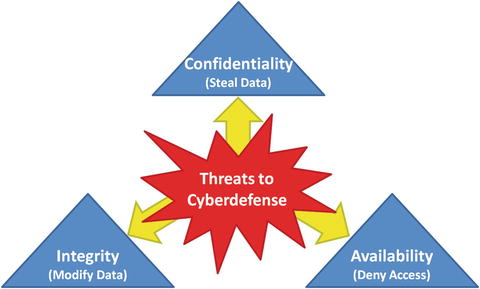
- Cyber- is a prefix that identifies properties related to IT systems including computers and computer networks
Cybersecurity Conundrum
- The reality is cyberthreats are just one of many threats against the enterprise and, from a budget perspective, are relatively small threats.
- Therefore, the enterprise has to prioritize limited resources to get the best possible security for the available budget.
- Cybersecurity will never be funded to do everything that is desired, or even mandated, by available best practice cybersecurity frameworks.
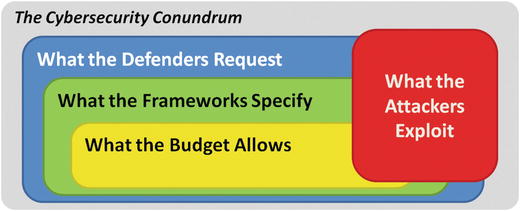
- Enterprise CEO to IT ManagerI want the truth!
- IT ManagerYou can’t handle the truth!
Axioms of a “Next-Generation” Cyberdefense
- Cybersecurity needs to be planned around the idea of achieving only partial security, rather than being resourced to do everything perfectly all the time.
- Major cybersecurity frameworks
- Lay out what the ideal practice should be; and
- Have little, if any, guidance on how to deploy a partial solution for available funding.
- Cybersecurity professionals must learn how to work with the business to find a balance between defenses that are only partially successfully, but effective in the eyes of the business.

The Cyberattacks of Today
- Compared to today, cybersecurity used to be relatively simple.
- Major cyberthreats were viruses, worms, and Trojan horses.
- Transformation started to take place.
- Cyberattackers started getting inside enterprise networks.
- Once inside, cyberattackers operated surreptitiously.
- We are using outdated, conventional defenses to guard against cutting-edge innovative malware. We are no more prepared to do this than a 19th-century army trying to defend itself against today’s weaponry. 1
- Common Cyberattacks
- Phishing / Spear Phishing
- Drive-By / Watering Hole / Malvertising
- Code Injection / Webshell
- Keylogging / Session Hacking
- Pass-the-Hash and Pass-the-Ticket
- Credential Harvesting
- Gate-Crashing
- Malware / Botnet
- Distributed Denial-of-Service (DDoS)
- Identity Theft
- Industrial Espionage
- Pickpocket
- Bank Heist
- Ransomware
- Webnapping
- Hijacking
- Decapitation
- Sabotage
- Sniper / Laser / Smart Bomb
- Smokeout / Lockout
- Infestation / Whack-a-Mole
- Burndown
- Meltdown
- Defamation
- Smokescreen / Diversion
- Fizzle
- Graffiti
- There is a rise of a new type of adversary—the Advanced Persistent Threat (APT).
- An APT attacker is skilled in the art of cyberattack and leverages IT technologies effectively to breach enterprises and systematically bypasses all their protections, one at a time.
- What makes APT different from earlier cyberattack types is the persistence of the attack.
- APT makes cyberattacks much more focused and effective because now they are under the control of an intelligent actor who has an objective to achieve.
- An APT attacker constantly adjusts the attack to get past the latest round of defenses.
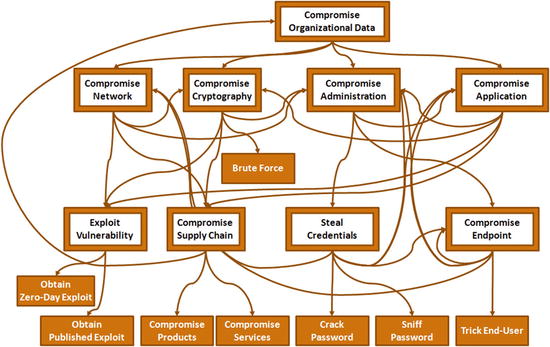
Successful Cybersecurity Program
Characteristics
- A cybersecurity program is about much more than buying cybersecurity technologies and deploying them.
- A successful cybersecurity program facilitates the coordination of policy, programmatics, IT life cycle, and cybersecurity assessments.
- These major components work together to guide, build, and operate an enterprise cybersecurity program.
Challenges
- Policy frameworks do not align well with how people are typically organized or with how cybersecurity is usually assessed.
- Programmatic frameworks focus on business considerations and deal with cybersecurity at a high level of abstraction such that their guidance is not actionable, except in the most general terms.
- IT life cycle frameworks deal with cybersecurity in broad terms and generally do not consider how cybersecurity needs to be decomposed for management and reporting purposes.
- Assessment frameworks tend to group cybersecurity controls and capabilities in ways that are not aligned with how people or budgets are typically organized.
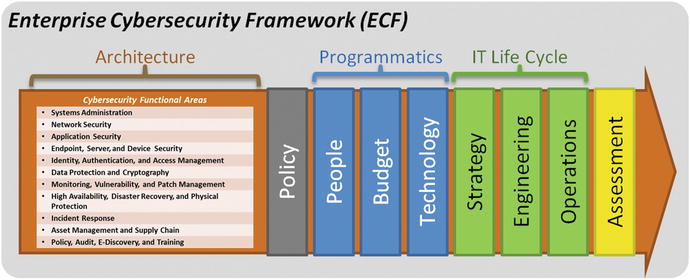
- Cybersecurity Program requirements include the following:
- Tie together architecture , policy , programmatics , IT life cycle , and assessments using a single Enterprise Cybersecurity Framework (ECF) for delegation and coordination.
- Break down enterprise cybersecurity into a number of sub-areas to communicate that there is more to effective cybersecurity than just firewalls and anti-virus software.
- Align sub-areas relatively well with real-world skills of cybersecurity professionals, budgets supporting those professionals, and technologies purchased and maintained with the budgets.
- Enable sub-areas quick and efficient reporting of cybersecurity status so executives can understand the big picture of what is and is not working well.
- Support the business decision-making process via the sub-areas and help leaders define strategy and prioritization.
Cybersecurity Program Cycle

- 1.Manage Enterprise Risks involves assessing risks to the enterprise and scoping enterprise IT systems to contain those risks and deploy mitigating controls and capabilities.
- 2.Assess Security involves evaluating the security that is currently deployed to assess its effectiveness and comprehensiveness compared to the negotiated business need.
- 3.Make Improvements involves planning improvements to enterprise cybersecurity by deploying or improving technologies and processes.
- 4.Security Capabilities are what are delivered by cybersecurity technologies and processes and what enable the enterprise to accomplish its cybersecurity objectives.
- 5.Security Controls apply those capabilities to address specific concerns, providing prevention, detection, forensics, or audit of the behavior that is of interest.
- 6.Operate Cybersecurity involves operating cybersecurity technologies, processes, capabilities, and controls to deliver cybersecurity to the enterprise.
- 7.Assess Operations involves measuring cybersecurity performance to understand what cybersecurity threats are occurring and how well defenses are serving to counter those threats.
- 8.Report Status involves reporting cybersecurity status both internally according to internally negotiated frameworks and standards, and externally to regulators, insurers, and other interested parties.
Future Discussion Topics
Part I: The Cybersecurity Challenge
- Chapter 1: Defining the Cybersecurity Challenge
- Chapter 2: Meeting the Cybersecurity Challenge
Part II: A New Enterprise Cybersecurity Architecture
- Chapter 3: Enterprise Cybersecurity Architecture
- Chapter 4: Implementing Enterprise Cybersecurity
- Chapter 5:Operating Enterprise Cybersecurity
- Chapter 6: Enterprise Cybersecurity and the Cloud
- Chapter 7: Enterprise Cybersecurity for Mobile and BYOD
Part III: The Art of Cyberdefense
- Chapter 8: Building an Effective Defense
- Chapter 9: Responding to Incidents
- Chapter 10: Managing a Cybersecurity Crisis
Part IV: Enterprise Cyberdefense Assessment
- Chapter 11: Assessing Enterprise Cybersecurity
- Chapter 12: Measuring a Cybersecurity Program
- Chapter 13: Mapping Against Cybersecurity Frameworks
Part V: Enterprise Cybersecurity Program
- Chapter 14: Managing an Enterprise Cybersecurity Program
- Chapter 15: Looking to the Future
Part VI: Appendices
- Appendix A: Sample Cybersecurity Policy
- Appendix B: Cybersecurity Operational Processes
- Appendix C: Object Measurement
- Appendix D: Cybersecurity Sample Assessment
- Appendix E: Cybersecurity Capability Value Scales
Contents
Part I: The Cybersecurity Challenge1
Overview
4
Topics
6
Context
7
Context
19
Context
35
Part II: A New Enterprise Cybersecurity Architecture93
Overview
220
Topics
221
Context
222
Service Models
225
Context
226
Authentication
231
Network Security
238
Part III: The Art of Cyberdefense275
Part IV: Enterprise Cyberdefense Assessment377
Part V: Enterprise Cybersecurity Program449
Part VI: Appendices513
Index701
Contents at a Glance
Part I: The Cybersecurity Challenge1
Part II: A New Enterprise Cybersecurity Architecture93
Part III: The Art of Cyberdefense275
Part IV: Enterprise Cyberdefense Assessment377
Part V: Enterprise Cybersecurity Program449
Part VI: Appendices513
Index701
About the Authors
Scott E. Donaldson’s

professional experience includes working in federal, commercial, and university marketplaces as well as in the defense industry. His expertise includes multimillion-dollar program management, systems development, information technology, business operations, business development, and technology cultural change. He has served in a wide variety of leadership roles including Chief Technology Officer (CTO), IT Director, Chief Systems Engineer (CSE), Program Manager, Line Manager, and Business Development Capture Manager. He has developed new technologies, techniques, and practices to bring in new business by solving real-world problems.
Donaldson teaches software engineering, software process improvement, and information management courses at the Johns Hopkins University’s Whiting School of Engineering. Johns Hopkins honored him in 2009 with an Excellence in Teaching Award. He has a BS in Operations Research from the United States Naval Academy and a MS in Systems Management from the University of Southern California.
Donaldson has co-authored three software engineering books:
Successful Software Development: Making It Happen
,
2nd Edition
(Prentice Hall PTR, 2001);
Successful Software Development: Study Guide
(Prentice Hall PTR, 2001); and
Cultivating Successful Software Development: A Practitioner’s View
(Prentice Hall PTR, 1997).
Donaldson has contributed to other software engineering books, including the
Encyclopedia of Software Engineering: Project Management—Success Factors
(CRC Press, 2010) and the
Handbook of Software Quality Assurance: Software Configuration Management—A Practical Look
,
3rd Edition
(Prentice Hall, 1999).
Donaldson also co-authored
CTOs at Work
(Apress, 2012) and
Enterprise Cybersecurity: How to Build a Successful Cyberdefense Program Against Advanced Threats
(Apress, 2015).
Stanley Siegel

has progressive professional experience as a systems engineer, mathematician, and computer specialist. He holds a nuclear physics doctorate from Rutgers University. He started his career with the US government in the Department of Commerce and then the Department of Defense. After his government service, he worked with Grumman for 15 years and Science Applications International Corporation (SAIC) for over 20 years. He helped SAIC grow to an 11-billion-dollar leader in scientific, engineering, and technical solutions with hundreds of millions of dollars in new business.
While at SAIC, he served as a senior technical advisor and director on a wide spectrum of projects in areas such as software engineering methodology assessment, software requirements analysis, software testing and quality assurance, and technology assessment.
In the 1990s, Siegel and Donaldson developed the Object Measurement Methodology, which appears in
Enterprise Cybersecurity
. This methodology can be used to quantify an enterprise’s cybersecurity effectiveness in warding off cyberattacks. As the book explains, the enterprise can improve its cyberdefenses by taking corrective actions by using this methodology.
Siegel and Donaldson have jointly taught graduate courses since the mid-1990s. They teach both in-class and online software systems engineering courses at Johns Hopkins University’s Whiting School of Engineering. Johns Hopkins honored them both in 2009 with an Excellence in Teaching Award.
Siegel has co-authored four software engineering books including the seminal software engineering textbook
Software Configuration Management: An Investment in Product Integrity
(Prentice Hall, 1980). He has contributed to a number of books, including the
Encyclopedia of Software Engineering: Project Management—Success Factors
(CRC Press, 2010) and the
Handbook of Software Quality Assurance: Software Configuration Management—A Practical Look
,
3rd Edition
(Prentice Hall, 1999).
Chris Williams

has been involved in the cybersecurity field since 1994. He has held both US military and commercial positions. He has been with Leidos (formerly SAIC) since 2003, focusing on enterprise cybersecurity and compliance. Previously, he worked with EDS (now HP) and Booz Allen Hamilton. He is a veteran of the US Army, having served five years with the 82nd Airborne Division and 35th Signal Brigade. He has worked on cybersecurity projects with the US Army, Defense Information Systems Agency, Department of State, Defense Intelligence Agency, and numerous other commercial and government organizations, designing integrated solutions to protect against modern threats. Williams holds a BSE in Computer Science Engineering from Princeton University and a MS in Information Assurance from George Washington University.
Williams co-authored
Enterprise Cybersecurity: How to Build a Successful Cyberdefense Program Against Advanced Threats
(Apress, 2015). He holds a patent for e-commerce technology and has published technical papers with the Institute of Electrical and Electronics Engineers (IEEE). He has presented on cybersecurity at RSA, Milcom, the International Information Systems Security Certification Consortium (ISC), the Information Systems Security Association (ISSA), and other forums.
Abdul Aslam

has over 20 years of experience in devising risk acceptance and compliance frameworks, application security, security operations, and information protection. He is the Director of Cyber Security Audit for Leidos tasked to evolve and maintain the corporate Cyber Security assessment and audit program. He was the Director of Cyber Security Governance, Risk, and Compliance for Leidos where he was in charge of delivering secure and scalable security solutions, policy governance, and strategic technology support. He has worked on numerous IT projects with a proven record of pioneering innovative systems analysis processes and secure application designs that improve availability, integrity, confidentiality, reliability, effectiveness, and efficiency of technology services.
Aslam has a MS in Systems Engineering Management and Information Assurance from the George Washington University and a BS in Engineering in Electronics and Telecommunications from Osmania University (India). He also has CISSP certification.
Aslam co-authored
Enterprise Cybersecurity: How to Build a Successful Cyberdefense Program Against Advanced Threats
(Apress, 2015) and has presented on cybersecurity at International Information Systems Security Certification Consortium (ISC)
2
and the Information Systems Security Association (ISSA).
Footnotes
..................Content has been hidden....................
You can't read the all page of ebook, please click here login for view all page.
